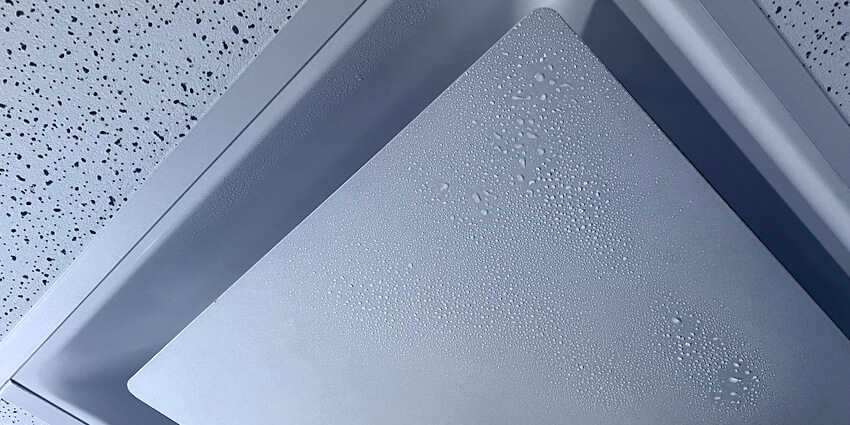How to Prevent Condensation in HVAC Grilles, Registers, and Diffusers (GRD)

Finishing a newly constructed building is a moment of great satisfaction and excitement for everybody involved. However, what if, after all the hard work and dedication, occupants begin to notice water dripping from the metal HVAC grilles when the air gets too cold? Or what if you hear clicking or popping noises coming from the linear diffusers as the air conditioning is cooling the space? These issues can be frustrating, and it's important to understand why these situations can occur. In the first of our two-part blog series, we’ll explore the effects of condensation on grilles, registers, and diffusers (GRDs) and how to prevent it.
What is condensation and why does it occur on HVAC grilles and diffusers?
When the difference in temperature between the supply air and the room air is too great, one may observe small water droplets forming on the surfaces of metal HVAC grilles and diffusers. If these droplets persist and grow over time, water may eventually drip from the metal components onto the floor or even onto occupants in the space. This phenomenon is known as condensation.
The air we breathe is a mixture of various molecules, with nitrogen and oxygen being the predominant components. Additionally, water is present in the air, with its concentration fluctuating between 3-5% depending on temperature and pressure. While water molecules in the air typically remain in the vapor phase, they can condense back into liquid form when warm, moist air comes into contact with a cold surface.
Most HVAC grilles, registers, and diffusers are constructed from steel or aluminum, both recognized for their excellent heat conductivity. Consequently, as conditioned air flows through these components, the metal surface temperature gradually changes until it approaches the supply air temperature. For example, in scenarios where cool supply air, such as 65°F, is introduced into a space, the metal surfaces will progressively decrease in temperature over time until they closely match the 65°F temperature. Insulation can slow down this process, but when cold air directly contacts metal, the metal surface will transfer heat to the airstream by convection and the temperature will decrease over time. If the metal surface temperature gets too low, droplets of water can form on this cold surface.
What is dew point and how it relates to condensation?
This is usually not a problem, but it can become problematic when a space has high humidity and very cold air is being used to cool down the room. Air behaves differently depending on how much water vapor is in the air at a given air temperature and pressure. Psychrometrics is the field of engineering that studies the behavior and science of water vapor and air mixtures. In psychrometrics, the dew point is the temperature at which the air is fully saturated with water vapor. The dew point depends on the humidity in the space and the temperature in the space. Condensation can occur when the supply air temperature or any surface in the space is cooled beneath the “dew point.” The dew point signifies that the air has the maximum amount of water vapor dissolved before it will begin to condense into a liquid. If the supply air temperature is set below the dew point in a space, there can likely be condensation on the metal grilles once their temperature decreases beneath the dew point temperature.
This is the reason why a cold glass of water can have droplets of water condensing on the outside surface of the glass. Once the glass surface cools down to a temperature lower than the dew point, water will begin to condense out of the air onto the surface. Condensation can pose an issue in a building that has high humidity levels when the space needs to be cooled quickly. In this situation, the supply air temperature might be brought down lower than usual in an attempt to cool the building quickly, but this can cause problems if the humidity levels are too high. Unfortunately, as the relative humidity (RH%) increases, so does the dew point temperature in the space. As the dew point increases, this means that water will more easily condense out of the air at those higher temperatures. In a very humid environment, the dew point could be as high as 75°F. A specific example would be a building with an air temperature of 85°F and a relative humidity of 70%. In this scenario, the dew point is 74.1°F. Due to this, any surface in that room with a temperature lower than 74.1°F will begin to condense water.
How to Avoid Condensation Problems
Condensation is a frustrating issue that can cause discomfort to occupants, or even cause water damage to walls or other surfaces. If you notice condensation in the building, or you fear it might occur, there are a few tactics you can employ to ensure it doesn’t happen. Since the problem is caused by a combination of high humidity and low supply air temperatures, there are a few ways to avoid the issue.
Solution 1: How to prevent condensation by decreasing the humidity level in the space
The first solution to protect against condensation would be to ensure that the relative humidity in the space is as low as possible before the air conditioning is turned on. Maintaining the relative humidity level between 30 and 50% is optimal and will result in most occupants feeling thermally comfortable. If the building is exceptionally large, it will be difficult to reduce the overall humidity of the entire space. But for offices or small spaces, a dehumidifier can work well to reduce the overall relative humidity. In small rooms, desiccants such as Damp Rid, or rock salt can also be effective at absorbing water from the air to reduce the relative humidity level. Once the humidity level drops, the dew point will also drop. At a relative humidity of 50% and temperature of 85°F, the dew point will be lower than 55°F. This means it’s highly unlikely that the supply air temperature will be cooled beneath this dew point which subsequently means that the metal products will not become cold enough to condense water droplets. Therefore, keeping the space humidity low (30-50%) is a surefire way to stop condensation.
Solution 2: How to prevent condensation by increasing the supply air temperature temporarily
The next solution to prevent condensation is to increase the supply air temperature so it’s above the dew point. For example, if a room has a temperature of 80°F and the humidity is 60% RH, then the dew point is 64.8°F. Therefore, if the air conditioning is set to 64°F, then there will likely be condensation on metal HVAC products in the room after some time. However, if you can temporarily raise the supply air temperature a few degrees higher, such as to 68°F in this situation, then the air temperature will be above the dew point and this will eliminate the possibility of condensation occurring. This tactic of temporarily increasing the supply air temperature a few degrees is also useful because as you cool down the space, the dew point will decrease and then you can safely lower the supply air temperature without worrying about condensation.
An additional method to reduce the risk of condensation: Apply insulation
An additional method to minimize the risk of condensation is to apply insulation to the metal HVAC components. This approach functions by impeding the heat transfer process and slowing down the rate of heat exchange. However, it's crucial to note that utilizing insulation alone cannot entirely eliminate condensation. While insulation can indeed diminish heat transfer between the air and the metal products, it serves to decelerate the heat exchange rather than bring it to a complete halt.
If any portion of the metal grille is in direct contact with the cold supply air, the cold air will carry away heat from the metal, causing the metal surface to cool down. While insulation can reduce the rate of heat transfer, it doesn't completely stop it. Therefore, condensation can still occur, but it might take a longer amount of time for droplets to begin to form. As such, decreasing the humidity level in the space or increasing the supply air temperature temporarily remain the sole authentic remedies capable of effectively stopping condensation.
To access Greenheck’s psychrometric calculator to help graph a building’s HVAC thermodynamic air conditions and processes, click here.
For more information on GRD products, click here or contact your nearby Greenheck representative.
To read part two of this two-part series, How to Prevent Thermal Expansion and Contraction in HVAC Grilles, Registers, and Diffusers (GRD), click here.
Read Next
How to Prevent Thermal Expansion and Contraction in HVAC Grilles, Registers, and Diffusers (GRD)


from